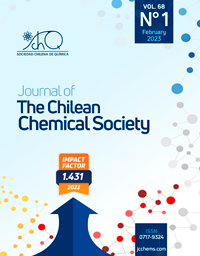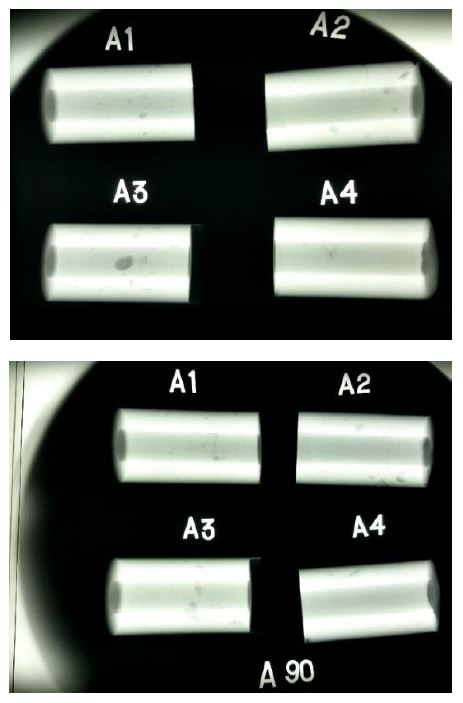
- Propellant combustion,
- Potassium Nitrate,
- calorimetry,
- solid rocket motor,
- solid propellant
Copyright (c) 2023 SChQ

This work is licensed under a Creative Commons Attribution-NonCommercial-ShareAlike 4.0 International License.
Abstract
The use of the Potassium Nitrate as an oxidizer in solid rocket propellants has been common in recent years for experimental research in solid rocket propulsion systems. This chemical is used as a compound of black powder and explosives, but in the last 30 years, it has been studied for applications in semiprofessional rocket propellant, implemented by Universities in research and academic projects. The Potassium Nitrate/Dextrose propellant is also known as Candy propellant and presents some advantages compared with other solid propellants. They are low production costs and ease of acquisition for the chemical components. These advantages are attractive for low-cost projects, compared to the low performance; this does not discourage its use.
The Candy propellant presented a lack of experimental data to characterize, for example, its thermal properties. For this reason, were used the Differential Scanning Calorimetry and the Semi-Micro Calorimetry tests, to obtain the heat of combustion, power, and temperatures of melting and ignition. The grains of Candy propellant were manufactured at the University of Conception by the Propulsion Interest Team. This is the first time which is reported the calorimetric data of the Candy propellant (Potassium Nitrate/Dextrose). The results in this work presented a heat combustion in the range 523 - 567 Cal·g−1, decomposition temperature in the range 356 - 361 °C and a heat released in the range 1080 - 1809 J·g−1 of the mixture KNO3/Dextrose, which contribute to the professional characterization of the propellant.
References
- Aziz, Amir, and Wan Khairuddin Wan Ali. 2011. Combustion Characteristics of AP Based Solid Rocket Propellant: Propellant Selection, Fabrication and Testing. VDM Verlad Dr. Müller.
- Bahdur, Arthur Durigan, Wilson K. Shimote, and Davi Mendes Tenorio. 2019. “ITA & IAE Solid Rocket Motor RDSX.” In AIAA Propulsion and Energy 2019 Forum, Reston, Virginia: American Institute of Aeronautics and Astronautics. https://arc.aiaa.org/doi/10.2514/6.2019-4153.
- Baldissera, Rafaela, and Matheus Poletto. 2018. “SOLID PROPELLANTS FOR ROCKETS: A METHODOLOGY TO OBTAIN HIGH PURITY KNO3 FROM AN INEXPENSIVE SOURCE.” International Journal of Research in Engineering and Technology 07(09): 52–56. https://ijret.org/volumes/2018v07/i09/IJRET20180709007.pdf.
- Bannach, Gilbert et al. 2009. “Thermal Stability and Thermal Decomposition of Sucralose.” Ecletica Quimica 34(4).
- Baran, Adam et al. 2015. “LSU Launch and Glide Program Development of a Solid and Hybrid Powered Rocket Glider: ‘Khaos.’” In 51st AIAA/SAE/ASEE Joint Propulsion Conference, Reston, Virginia: American Institute of Aeronautics and Astronautics, 1–36. http://arc.aiaa.org/doi/10.2514/6.2015-4117.
- Bontorin, Daniel et al. 2016. “AIAA 2016-4937 ITA Candy Rocket Motor Design and Solid Propellant Manufacture Challenges.” In 52nd AIAA/SAE/ASEE Joint Propulsion Conference, Reston, Virginia: American Institute of Aeronautics and Astronautics, 1–9. http://arc.aiaa.org/doi/10.2514/6.2016-4937.
- ———. 2017. “Candy Propellant Casting Machine.” In 53rd AIAA/SAE/ASEE Joint Propulsion Conference, 2017, Atlanta, 1–9.
- Bossard, Jhon A., and Noah O. Rhys. 2010. “Propellant Readiness Level: A Methodological Approach to Propellant Characterization.” In AIAA Joint Propulsion Conference, https://ntrs.nasa.gov/search.jsp?R=20100032406 2019-12-09T20:19:13+00:00Z%0APropellant.
- Davenas, Alain. 1993. SOLID ROCKET PROPULSION TECHNOLOGY. Pergamon Press.
- Fahd, Ahmed, Hosam E. Mostafa, and Sherif Elbasuney. 2017. “Certain Ballistic Performance and Thermal Properties Evaluation for Extruded Modified Double-Base Propellants.” Central European Journal of Energetic Materials 14(3): 621–35.
- Frem, Dany. 2018. “A Reliable Method for Predicting the Specific Impulse of Chemical Propellants.” Journal of Aerospace Technology and Management 10. http://www.jatm.com.br/ojs/index.php/jatm/article/view/945 (October 2, 2020).
- Hansson, Jan. 1983. Testing Propellants by Calorimetry. https://www.tainstruments.com/pdf/literature/M101.pdf (October 2, 2020).
- Heil, Moritz, Jürgen Hickmann, and Christian Müller. 2019. “Thermal Characterization of Naturally Aged Propellants.” Propellants, Explosives, Pyrotechnics 44(6): 687–95.
- Herder, G, F P Weterings, and W P C De Klerk. 2003. “MECHANICAL ANALYSIS ON ROCKET PROPELLANTS.” Journal of Thermal Analysis and Calorimetry 72: 921–29.
- Jawale, Lalita S. et al. 2013. “Effect of Experiment Environment on Calorimetric Value of Composite Solid Propellants.” Defence Science Journal 63(5): 467–72.
- Kishore, K, V R Pai Verneker, and A Sameena Begum. 1982. “Calorimetric Values of Composite Solid Propellants.” Thermochimica Acta 54(1): 141–46. http://www.sciencedirect.com/science/article/pii/0040603182850727.
- Kubota, Naminosuke. 2015. Propellants and Explosives: Thermochemical Aspects of Combustion. 3rd ed. Weinheim, Germany: Wiley-VCH.
- Nakka, Richard A. 1984. “Solid Propellant Rocket Motor Design and Testing.” University of Manitoba. https://nakka-rocketry.net/download.html.
- Okninski, Adam et al. 2015. “Development of the Polish Small Sounding Rocket Program.” Acta Astronautica 108: 46–56. https://www.sciencedirect.com/science/article/pii/S0094576514004986?via%3Dihub (June 1, 2018).
- Olaoye, O S, and O A Abdulhafeez. 2014. “Design and Performance Characteristics of a Rocket Using Potassium Nitrate and Sucrose as Propellants.” International Journal of Science and Research (IJSR) 3(8): 1892–97.
- Olde, Martin C. 2019. “Potassium Nitrate Sorbitol Propellant: Experimental Investigation of Solid Propellant Characteristics.” Delft University of Technology.
- Olde, Martin C. 2018. Performance of a Potassium Nitrate Sorbitol Rocket Motor MSc Literature Study.
- Oyedeko K.F.K, and Egwenu S. O. 2021. “Modelling of the Formulated Solid Rocket Propellant Characteristics.” Global Journal of Engineering and Technology Advances 6(2): 061–073.
- Pal, Yash, Anthony Raja, and Kavitha Gopalakrishnan. 2020. “Theoretical and Experimental Heat of Combustion Analysis of Paraffin-Based Fuels as Preburn Characterization for Hybrid Rocket.” Journal of Aerospace Technology and Management 12(12). https://www.scielo.br/pdf/jatm/v12/2175-9146-jatm-12-e4520.pdf (July 1, 2022).
- Park, Sungjun, and Sunghan Choi. 2020. “A Study on the Characteristics of Solid Propellant Using a Defoamer.” Propellants, Explosives, Pyrotechnics 45(3): 486–92.
- PARR Instrument Company. 1991. 1425 Semimicro Bomb Calorimeter Operating Instruction Manual. https://www.parrinst.com/products/oxygen-bomb-calorimeters/previous-calorimeter-models/.
- Patil, Prajakta R., V. N. Krishnamurthy, and Satyawati S. Joshi. 2006. “Differential Scanning Calorimetric Study of HTPB Based Composite Propellants in Presence of Nano Ferric Oxide.” Propellants, Explosives, Pyrotechnics 31(6): 442–46. http://doi.wiley.com/10.1002/prep.200600059.
- Pradhan, S. K., Vedant Kedia, and P. Kour. 2020. “Review on Different Materials and Their Characterization as Rocket Propellant.” Materials Today: Proceedings 33: 5269–72.
- Rastogi, R P, K Kishore, and Gurdip Singh. 1975. “Solid Propellant Decomposition Studies by Differential Scanning Calorimetry.” Thermochimica Acta 12(1): 89–96. http://www.sciencedirect.com/science/article/pii/004060317585012X.
- Seibert, Günther. 2006. European Space Agency - History Study Reports ESA HSR The History of Sounding Rockets and Their Contribution to European Space Research.
- Siahi, Mohammad Reza, Soma Rahimi, and Farnaz Monajjemzadeh. 2018. “Analytical Investigation of the Possible Chemical Interaction of Methyldopa with Some Reducing Carbohydrates Used as Pharmaceutical Excipients.” Advanced Pharmaceutical Bulletin 8(4): 657–66.
- SQM. 2014. “Qrop K Especificaciones Técnicas.” http://www.sqm-vitas.com/Portals/55/pdf/qr_k.pdf (July 20, 2020).
- Sutton, George P., and Oscar Biblarz. 2010. Rocket Propulsion Elements. 8th ed. Wiley.
- Wada, Yutaka et al. 2018. “Development of a Candy Hybrid Rocket Motor for Undergraduate Space Education.” TRANSACTIONS OF THE JAPAN SOCIETY FOR AERONAUTICAL AND SPACE SCIENCES, AEROSPACE TECHNOLOGY JAPAN 16(6): 506–10. https://www.jstage.jst.go.jp/article/tastj/16/6/16_506/_article.


